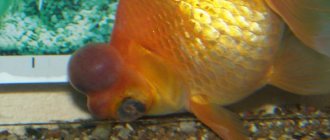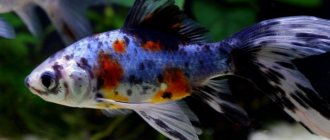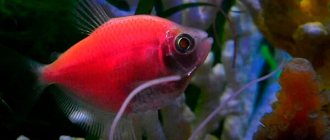Comet (Carassius gibelio forma auratus) Bloch 1782, one of the breeding forms of the aquarium goldfish, characterized by an elongated forked caudal fin resembling the tail of a comet.
Like other goldfish, it is a freshwater species from the carp family.
Comets are now the most common type of goldfish in the world. These are large fish, so they are best kept in open ponds or large aquariums.
History of the species
While goldfish have been bred in Asia for thousands of years, Comets are a newer variety, having only been around since the late 1800s. There is still much about their history that remains unknown, but here are some facts:
- In 1878, the newly created US State Fish Commission began importing goldfish from Japan and raising them in ponds along the Washington Trade Center. To encourage Americans to get into aquarium farming.
- It is believed that an American government official named Hugo Moulert either bred the first line of Comets from these ponds or was responsible for introducing and popularizing the variety in the United States.
- Mr. Mulert published some of the first books in the United States on goldfish care and breeding. He was also the person who popularized the name "Comet" for this species.
- The Comet's long forked tail may have come from a mutation of the Riukin or Veiltail goldfish, but it is believed that they were bred from a line of common goldfish and Prussian carp.
A popular red and white pond fish known as Sarasa's comet. With dark red and pure white colors, they are attractive, hardy and large fish.
Description
They have an elongated body, like all fins. The caudal fin is single, with a deep notch.
Unlike the slightly slimmer common goldfish, comets are more rounded and have a deeper curve in the dorsal and ventral lines, but do not have the short or round body typically seen in some goldfish species.
Their deeply forked and widely spaced caudal fin is usually about the same length as the body and is emphasized by a narrow tail base. Thus, a comet 20 cm long would have a tail of about 10 cm and a silhouette like an hourglass.
Comet Black (Comet Goldfish) color variations
Comet Calico or Shubunkin (Comet Goldfish) color variations
Comets are usually one or two colors. The most common colors are shades of red, orange, yellow and white, although green and chocolate may also be available. They always have a metallic color (fish with pearlescent scales are called Shubunkin, even if they come from the Comet line).
The most popular morphs are the two-tone red and white and the extremely coveted red-capped Comet Saras, a goldfish with a koi coloring pattern.
Size:
Similar in size to the common variety, adults are typically 20 to 30 cm long from snout to tip of tail.
They grow quite quickly in the first few weeks, but will actually take about 3-4 years to reach their full potential.
External features
Comet fish (aquarium) has a bright and memorable appearance. Its body is slightly elongated, with a luxurious forked tail, which is usually several times the size of its body. The price of this fish depends on its length - the longer it is, the more expensive the individual is.
The elongated lower and dorsal fins add grace to the comet's appearance. The length of the fish is 18 centimeters. She is one of the longest-living fish in the aquarium. With proper care, she lives 14 years. Comet fish can have different colors - from light yellow with small white patches to very dark, almost black. Color is influenced by:
- aquarium lighting;
- feed;
- varieties and number of plants;
- presence of shaded areas.
And although the color can be quite varied, fish whose fins have a different color from the body color are of particular value. Today, yellow, silver or golden specimens are common. Silvery comets have orange spots on their bodies.
A silvery comet with a bright red tail is considered very valuable. Much more often, this species has a red-orange body interspersed with yellow or white. Interestingly, due to lighting or nutrition, this fish is able to change its color. To keep it in its original form, you must follow simple rules for its content. We will talk about them further.
Behavior and Compatibility
Sociable and curious, they are peaceful fish. They are not demanding on water parameters and remain healthy with minimal care. Can be kept with many other fish species with similar conditions, except the more aggressive ones. Avoid keeping with small freshwater snails or shrimp, which may be eaten.
These are hardy fish that are easy to care for. It is best to keep them in ponds that mimic their natural environment and have enough space for them to fully develop. They prefer to stay in groups. They do best when kept with other comets, common goldfish or koi, rather than alone.
You might think that these fish get along with almost anyone. However, although they live in fresh water, like most others, the temperature suitable for them is much lower. For this reason, you cannot keep them with fish that need warmer water.
They are very active and swim throughout the aquarium and even stick together when kept in groups. These fish are not aggressive, but they often push each other or other fish when feeding and will certainly swallow smaller animals if they fit into their mouths.
Like many other fish, it is susceptible to ichthyophthyriasis. It is easy to identify by its white color. Comets are also susceptible to external parasites and bacterial infections. All of them are treatable and can be prevented under the right conditions.
To see if your comet fish are healthy, it's worth paying attention to their color. They should always be brightly colored and nothing should cling to their scales. If you notice a decrease in appetite in your fish, this is an indication that they are not feeling well.
Differences between a female and a male
To determine male or female, each sex has characteristics.
Females:
- More active.
- Larger, larger size.
- Brighter colored.
- The pelvic fins are pointed.
- The anus is convex.
- During spawning, the abdomen becomes rounded and inflated.
Males:
- Less active.
- The pelvic fins are shortened and rounded.
- The hard area between the anus and abdomen.
- There is a growth at the back of the abdomen.
- The anal opening is concave.
- During the spawning period, they remain elongated and flattened, and white stripes appear near the gills.
Spawning
After the males courtship and the eggs are fertilized, the female is capable of laying 10 thousand eggs. After spawning, the parents are transferred back to the community aquarium because they are able to eat the eggs or fry. The fry hatch in 1–2 weeks, and become active and ready to consume food after another half a week. They are fed daphnia, living dust.
Aquarium
Due to their high activity levels, they need more space than other types of goldfish. They are an ideal choice for an outdoor pond, although they also work very well in aquariums.
The larger the aquarium, the better - preferably at least 120 cm for a group or 50 liters per fish for long-term use. Juveniles can be introduced into a smaller aquarium and then transferred to a larger aquarium or pond as they mature.
They prefer natural light and are not afraid of brightly lit areas, so you can use any type of aquarium lighting. Although goldfish love aquariums with live plants, they are known to pull out roots and eat vegetation.
If you nevertheless decide to decorate the aquarium with live plants, you can plant slow-growing species, such as Echinodorus and Anubias, along with fast-growing ones, such as hornwort. Plants with floating leaves are also great; they will create the atmosphere of a natural biotope - a pond or lake.
You can use plastic plants and any other decorations you like, but avoid anything with sharp or jagged edges that could injure the fish.
One thing to keep in mind is that they do produce a significant bioburden and require powerful filters.
External filters that support large populations of nitrifying aquatic bacteria and mimic the detoxifying effect of a pond system are an excellent option for keeping large goldfish tanks clean and healthy.
Water parameters:
Temperature: 18 - 23° C pH: neutral, 6.0 - 8.0 Hardness: 5-19° dGH
They are not picky about water parameters, but prefer stable and constant conditions. Rapid changes in temperature or pH can stress them out and weaken their immune system, so be sure to make any changes slowly to give them time to acclimate.
They do not require special care other than regular maintenance. To keep your fish healthy, just make sure they always have clean water. Plan to change the water about 25% once a week.
Nutrition
Natural food sources include insects and their larvae, aquatic invertebrates, plants and detritus. In an aquarium or pond they will accept a wide range of dry and frozen foods.
Comets are typical goldfish, they have an excellent appetite and are always ready to eat. These omnivorous fish are really easy to overfeed, and obesity is a common problem that can shorten their lifespan and increase their risk of developing diseases. Therefore, be sure to provide your fish with a balanced and high-quality diet.
It is best to feed two juveniles and once a day for adults and give them as much food as they can eat in a couple of minutes. Don't feed one day a week - have a fasting day.
Basic diet of high quality goldfish flakes or pellets.
Consider additional natural protein feeding, dry and frozen food, they will definitely appreciate the occasional bloodworm, gammarus, etc. in their diet.
They will also need a healthy source of vegetables. Tasty greens that will help balance your diet include pieces of lettuce, broccoli, peas, carrots, cucumber, seaweed and the list goes on. Occasionally give them berries, such as strawberries, to replenish their vitamin reserves.
Diseases
- Overfeeding. If the fish turns over with its belly up after feeding and its belly is swollen, this means that the fish regularly overeats. To help the fish, do not feed it for a couple of days and add a weak solution of potassium permanganate to the water.
- Dropsy. With dropsy, the scales rise, puff up, bulging eyes appear, and the back becomes bent. For treatment, place the sick resident in a separate container and replace part of the water daily by adding a weak solution of potassium permanganate.
- Scabies. Appears when water is poisoned, for example, by decaying food. Symptom - the fish constantly rubs against rough surfaces, behaves nervously and lethargically. To cure the fish, transplant it into a container with slightly salted and cool water.
- Changeling. The fish begins to swim upside down for no apparent reason. For treatment, the water level is lowered to 6 cm and the water is heated a couple of degrees. They feed only small live food.
(Visited 1,043 times, 1 visits today)
Breeding
Comets are one of the easier goldfish species to breed because they are more agile than twin-tailed fish. But raising single-tailed goldfish in aquariums is difficult unless they are spacious, and the best way to raise these beautiful fish is in an outdoor pond.
Since different types of goldfish can easily and freely interbreed with each other, if you want to produce pure offspring, you need a single species aquarium. For reproduction you will need a pair or group of fish - 4-5.
It doesn't take much effort to stimulate reproduction. All you need to do is make sure that the water parameters are suitable, and the fish will do the rest. A separate aquarium will be needed to separate the spawners from the eggs after spawning.
It is necessary to slowly reduce the water temperature to 15-16° C.
The next step is to gradually increase the water temperature, a little, 1-2 degrees every day, until you reach 22-24° C. This will be enough to stimulate reproduction, since goldfish tend to breed in warmer water. Increasing the temperature is necessary to imitate natural changes in nature.
At this time, the fish should eat well, with food high in protein, such as bloodworms. When you see males chasing females around a pond or aquarium, it means everything has worked out and breeding is about to begin.
The color of the fish will become brighter and darker. Females lay eggs on plants, about 1000. Males will then fertilize them, spawning only taking a few hours. Comets, like all goldfish, do not care for their offspring, so you need to remove the producers immediately after the end of spawning.
After a week, you can see the fry swimming around the aquarium. During this time, you should give them powdered or liquid fry food until they are large enough to eat brine shrimp nauplii or a suitable sized food.
The juveniles will appear black or brown for the first few months of life until they begin to develop their colors.
Lifespan
With proper care and attention to diet and water quality, Comet goldfish typically live about 10 to 15 years in an aquarium or pond. There have been reports of goldfish living up to 30 and even 40 years, so these fish can keep you company for a long time.
Comet reproduction
Comet spawning occurs in April and May. It is active, starting early in the morning and lasting until 7 am. Two or three males disperse the female, who lays some of the eggs and the males immediately fertilize her. After spawning, adult fish must be transplanted into another body of water, otherwise they will eat all the eggs, which are very attractive to them. The eggs mature in 4 to 5 days. Unfertilized eggs become cloudy, but fertilized eggs, on the contrary, turn pale and become almost transparent. From which comet larvae emerge on the fifth day.
A newly hatched larva is one to two millimeters long and has the appearance of a thread with prominent eyes and a yolk sac, which contains the necessary supply of nutrients for the first three days of life. As the contents of the yolk sac are consumed, the larvae begin to move more actively, eventually they become able to reach the surface of the water and fill the swim bladder with air, after which they can assume a horizontal position. From this moment on, the larvae begin to move and feed independently.











